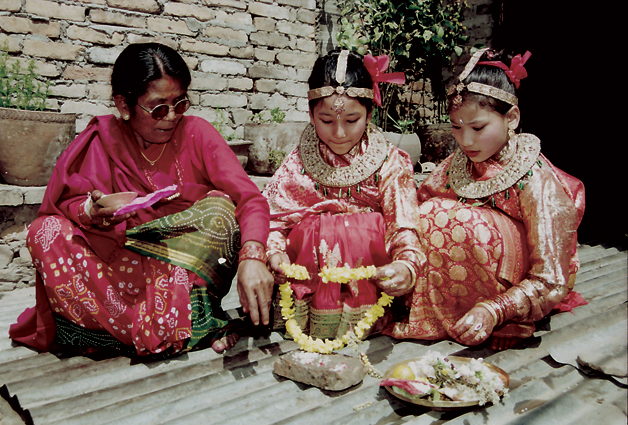
The tradition of Gufa or Barah in Newar culture was born out of practical reasons. Simply put, it is a ritual of keeping a young girl pure for her marriage to the sun before she experiences her first menstruation. This, along with another similar ceremony called Ihi, a marriage with a bael fruit at a still younger age ensures that a Newar girl is never really widowed in her life. Barah in the Nepali language means twelve, which stands for the twelve days that a young girl is kept inside a darkened room as preparation for her marriage to the sun. Richa Shakya, now a first year Social Work student, who thinks the ritual is quite romantic, needed no persuasion to go through the twelve days leading to her marriage to the sun.
“It was really quite a lot of fun,” she reminisces. “I remember my father sticking up newspapers on the window panes in my room to keep the sunlight out as is the tradition. I was not allowed to look at men for the entire twelve days. The whole idea of marrying the sun did seem like a fairytale to me at the time.”
Tradition dictates that the girl should not be allowed to look at men or even hear a male voice for the duration of the ceremony. In earlier days, a young girl would be literally kept in pitch darkness. But with modern times, the rules have now been relaxed and televisions and audio equipment are allowed in the room. About this, Richa says “I did have a T.V in my room, but with all my friends and cousins coming in to see me and with all the games we played, I hardly watched any TV.”
In earlier times, a young girl during Barah would not be allowed to eat any salted food, and meat was strictly prohibited for the entire duration of the ceremony. No washing up or cleaning was allowed either. “I remember that I was not allowed to wash my face, nor comb my hair or even use a mirror the entire time. So after I came out, it did feel a little different looking at myself after so long. I even had to wear the same clothes for the entire twelve days which was quite uncomfortable,” Richa elaborates, “Cousins and friends who came to visit me, if they were familiar with the rituals, brought sweets and popcorn and I remember playing Gotti a lot.” Gotti is a popular game played by Nepali children using small pebbles.
“I clearly remember feeling a little embarrassed when the day arrived for my marriage to the sun,” Richa says with a huge grin on her face. “I knew there would be people and I knew that I was going to be wearing traditional bridal costumes like an embroidered sari. The eleventh night was the last night inside the room and I remember that we took the fun and laughter up a few notches.” The eleventh night is also the night when the girl is supposed to be visited in her sleep by a Khyak, or an incubus. Richa however, had no such experience. The Khyak is represented by a small idol made out of cotton nowadays.
“On the twelfth day, without eating anything, I was prepared for the main ceremony. I wore a brilliant red sari with a lot of gold jewelry and put on make up for the first time. The first one I had to lay my eyes upon after I came out of the room was to be the Sun God, so I came out of my room, face down towards the ground and walked straight up to the terrace. I was made to look at the sun in its reflection in a golden plate filled with water, using my hands as a frame and then slowly raise my hands to actually look at the sun in the same frame.”
“A ceremony not different to a traditional Newar marriage took place and I was later taken to the local Ganesh temple for yet another puja ceremony. The clothes that I wore inside the room were taken away by the family priest and his tearing of a shred of paper from the windows of my room actually marked the end of my Barah ceremony.”
“Spending twelve days in a room untouched, unseen by any man before marrying the sun for me, symbolized a show of purity and faith in God,” Richa explains. “I did not at all mind staying in a room for twelve days accompanied only by the women of my family and friends. It did instill some values in me that are expected in Newar society.” Although the supposedly inhumane act of putting a young girl in a dark room for twelve days has triggered quite a few lively debates, romanticizing the event like Richa Shakya does, seems like a good reason for keeping the tradition alive.










